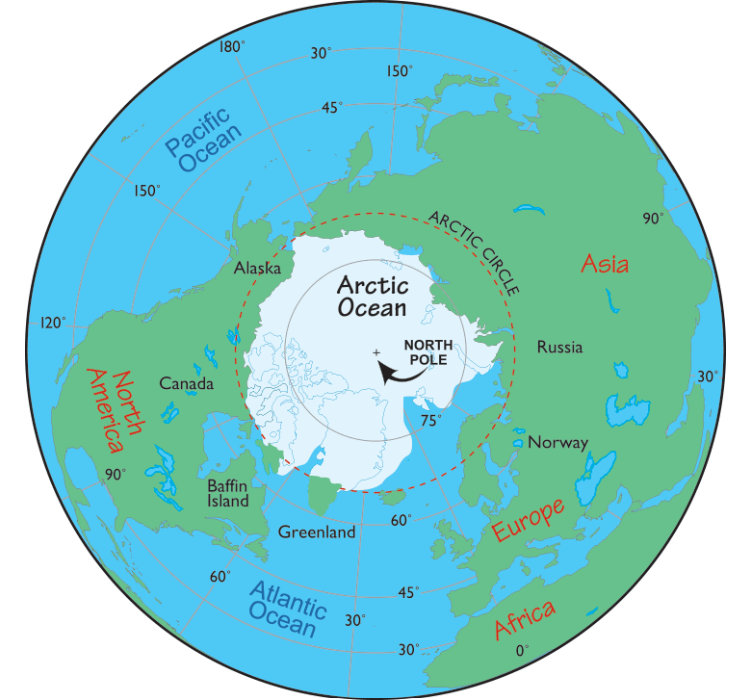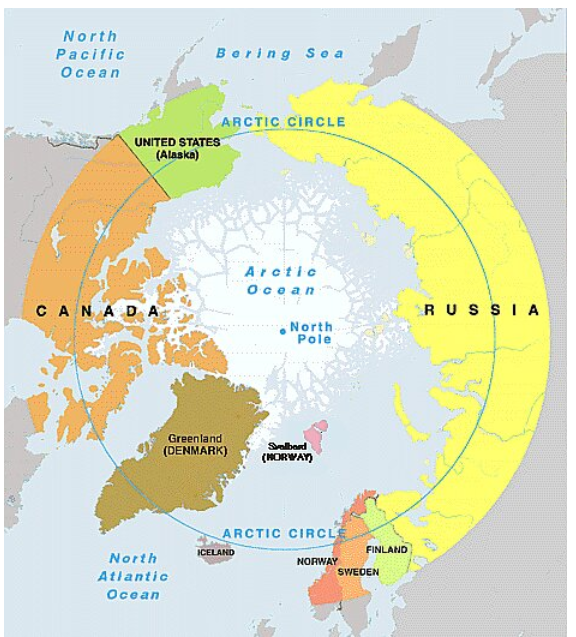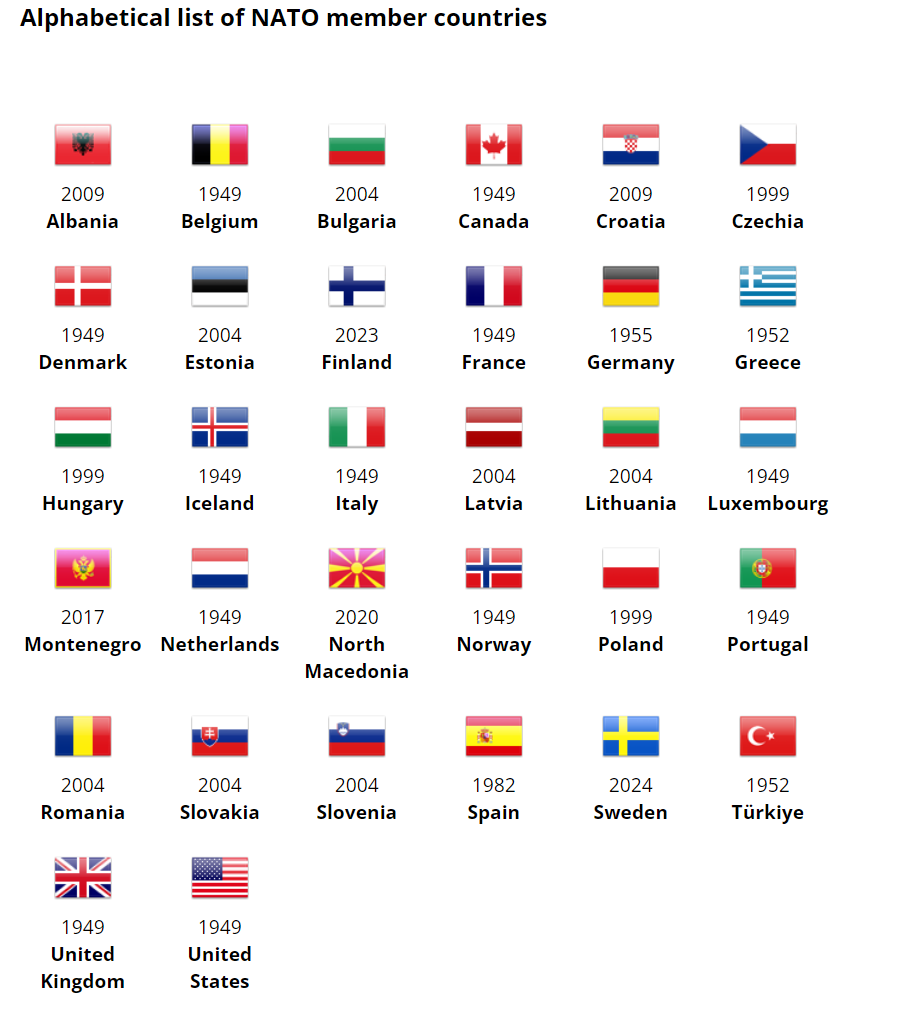CONTENTS
- India’s Inaugural Winter Expedition in the Arctic
- The 75th Anniversary of North Atlantic Treaty Organization (NATO)
India’s Inaugural Winter Expedition in the Arctic
Context:
In December 2023, upon their arrival in Oslo, four climate scientists from India embarked on their preparation for India’s inaugural winter expedition to the Arctic. Their anticipation was tinged with uncertainty as they began adjusting to the new environment. Himadri, India’s research station within the International Arctic Research Base in Svalbard, Norway, had previously accommodated missions exclusively during the summer months but winter posed new challenges.
Relevance:
GS2-
- Important International Institutions
- Groupings and Agreements Involving India and/or Affecting India’s Interests
- Regional Groupings
GS3- Conservation
Mains Question:
Examine the evolution of India’s engagement in the Arctic over the years. Also, discuss the significance of India’s inaugural winter expedition in the Arctic. (15 Marks, 250 Words).
About the Winter Expedition in the Arctic:
- Venturing into the Arctic winter meant confronting the challenges of enduring extreme cold, with temperatures plummeting as low as -15 degrees Celsius, following a demanding period of acclimatization. Adding to their apprehension was the formidable prospect of enduring polar nights.
- By March 2024, India’s inaugural winter expedition in the Arctic concluded successfully, marking a significant milestone in its Arctic endeavours.
- While the scientists undoubtedly take pride in their achievement, India’s historical reluctance to engage in year-round Arctic missions prompts a need for reflection.
- For more than a decade, India’s National Centre for Polar and Ocean Research had not deemed a winter mission to the Arctic necessary.
- However, a shift in Indian policy occurred, ostensibly driven by scientific evidence indicating accelerated warming in the Arctic region.
- As data emerged linking the melting of Arctic Sea ice to potentially catastrophic climate events in India, policymakers found themselves compelled to take action.

Significance of the Winter Expedition in the Arctic:
- New Delhi recognizes the significance of the opening up of Arctic Sea routes, particularly the Northern Sea Route, and seeks to channel Indian trade through this region.
- This strategic move holds the potential to decrease costs for shipping companies by reducing time, fuel, and security expenditures associated with transporting goods.
- Another rationale for the same is rooted in geopolitics. India has become increasingly wary of China’s expanding investments in the Arctic, particularly concerning Russia’s decision to grant China expanded access to the Northern Sea Route.
- This development has heightened India’s concerns. Moreover, India’s heightened focus on the Arctic coincides with escalating tensions in the region, fuelled by the Russia-Ukraine conflict and exacerbated by the suspension of various regional cooperative forums.
- There are apprehensions regarding the potential ramifications of these tensions, particularly concerning Russia’s increased reliance on its nuclear deterrent on the Kola Peninsula.
- For India, which aims to maintain constructive relations with both Western nations and Russia, these developments carry significant strategic implications.
Evolution of India’s Engagement in the Arctic:
- Certainly, India’s engagement in the Arctic is not a recent development. Its involvement traces back to 1920 with the signing of the Svalbard Treaty in Paris.
- In 2007, India embarked on its initial research expedition, delving into Arctic microbiology, atmospheric sciences, and geology.
- Just a year later, India distinguished itself as the sole developing nation, alongside China, to establish an Arctic research base.
- Following its attainment of ‘observer’ status by the Arctic Council in 2013, India proceeded to install a multi-sensor moored observatory in Svalbard in 2014 and an atmospheric laboratory in 2016.
- The research conducted at these facilities is centered on studying Arctic ice systems and glaciers, and assessing the impact of Arctic melt on the Himalayas and the Indian monsoon.
Views Regarding India’s involvement in the Arctic:
- Nevertheless, the question of India’s involvement in the Arctic remains a topic of contention within the country’s academic and policy circles. Divergent views exist regarding the potential ramifications of the changing Arctic climate on India’s economy.
- The primary concern revolves around the extraction of fossil fuels through mining in the region, an area where India has yet to outline a coherent economic strategy.
- Proponents of economic activities in the Arctic advocate for a pragmatic approach, particularly concerning oil and gas exploration and mining.
- Conversely, sceptics highlight the potential environmental repercussions and emphasize the necessity for a more balanced policy framework that acknowledges the adverse impacts of maritime resource exploitation.
India’s Current Policy:
- The potential for collaboration between Norway, the current chair of the Arctic Council, and India is rooted in their longstanding relationship, which dates back to the late 1980s.

- Over the years, the two nations have partnered to investigate the evolving conditions in both the Arctic and Antarctic regions and their repercussions on South Asia.
- As the impacts of climate change become increasingly pronounced in the Arctic and intertwine with the South Asian monsoon, these collaborative efforts have gained momentum.
- India’s current policy emphasizes cooperation with Arctic nations, particularly in the realms of green energy and clean industries, aiming to enhance its image as a responsible stakeholder on the global stage.
- Notably, partnerships with Denmark and Finland have materialized in various areas, including waste management, pollution control, renewable energy, and green technology.
Way Forward:
- Many stakeholders perceive a potential partnership with Norway as transformative for India. Such collaboration could facilitate increased Indian involvement in the Arctic Council’s working groups, addressing crucial issues such as the blue economy, connectivity, maritime transportation, investment, infrastructure, and responsible resource development.
- While the Indian government expresses interest in benefiting from activities like seabed mining and resource exploitation in the Arctic, it must unequivocally endorse sustainable extraction practices to ensure long-term environmental integrity.
- Naturally, a collaboration with Norway is expected to prioritize scientific research and efforts towards climate and environmental protection.
- These areas align with two of the key pillars outlined in India’s Arctic Policy, alongside economic and human development, transportation and connectivity, governance and international cooperation, and national capacity building.
- Despite this focus on scientific and environmental concerns, India may still seek to explore economic prospects in the Arctic.
Conclusion:
Hence, Norway could play a pivotal role in helping India formulate a sustainable policy that addresses the needs of both the scientific community and industry. Given the escalating global geopolitical tensions in the Arctic, finding constructive and mutually beneficial approaches to mitigate pressure becomes crucial for both India and Norway.
The 75th Anniversary of North Atlantic Treaty Organization (NATO)
Context:
The North Atlantic Treaty Organization (NATO), celebrating its 75th anniversary, faces significant challenges, notably criticism from certain European countries and the rise of right-wing nationalist movements. These challenges necessitate a careful and balanced approach to maintain relevance in the 21st century.
Relevance:
GS2
- Bilateral Groupings and Agreements
- Important International Institutions
Mains Question:
In the context of the 75th anniversary of the North Atlantic Treaty Organization (NATO), discuss the challenges faced by it in the current geopolitical landscape. Should India consider joining the grouping by ceding to the offer by United States? Substantiate with arguments. (15 Marks, 250 Words).
About NATO:
- The North Atlantic Treaty Organization (NATO) is a military alliance formed by the North Atlantic Treaty, also known as the Washington Treaty, which was signed in April 1949 by the United States, Canada, and several Western European nations with the aim of ensuring collective security against the Soviet Union.
- The original members of NATO included Belgium, Canada, Denmark, France, Iceland, Italy, Luxembourg, the Netherlands, Norway, Portugal, the United Kingdom, and the United States.

- Its headquarters are located in Brussels, Belgium, with the headquarters of Allied Command Operations situated in Mons, Belgium.
Objectives of NATO:
- NATO’s overarching objective is to safeguard the freedom and security of all its members through both political and military means.
- Politically, NATO works to promote democratic values and facilitates member nations in consulting and cooperating on defense and security-related matters to foster problem-solving, trust-building, and ultimately conflict prevention.
- On the military front, NATO is committed to resolving disputes peacefully. However, in cases where diplomatic efforts fail, NATO possesses the military capability to undertake crisis-management operations.
- These operations are conducted either under the collective defense clause of NATO’s founding treaty, Article 5 of the Washington Treaty, or under a United Nations mandate, either independently or in collaboration with other nations and international organizations.
- NATO has invoked Article 5 only once in its history, on September 12, 2001, in response to the terrorist attacks on the World Trade Center in the United States, commonly known as 9/11.
- Its enduring credibility as a guarantor of security and protection against aggressors hinges on its steadfast commitment to unity and relevance amidst evolving geopolitical landscapes.
Recent Developments:
NATO’s Military Capacity and US Domination:
- NATO’s military capacity is increasingly seen as a tool for the United States to maintain dominance over nations that are not perceived as military threats.
- There is an urgent need to dispel such perceptions of supremacy, highlighted by NATO’s involvement in over 200 military interventions worldwide in the past 75 years.
- Among these, 20 major interventions, such as the controversial outcomes of counterterrorism efforts in Afghanistan, unauthorized interference in Syria, the invasion of Iraq, bombings in Yugoslavia, destabilization of Libya, and inadvertently contributing to the emergence of ISIS, have raised concerns.
- NATO, comprising 32 member states and five aligned nations such as Japan, New Zealand, Israel, Australia, and South Korea, must bolster defense capabilities and security arrangements. This will foster mutual trust and improved cooperation among member nations.
Military Aid Package to Ukraine:
- Furthermore, NATO Secretary-General Jens Stoltenberg has proposed a $100 billion military aid package to Ukraine over five years, as a precautionary measure against a potential cessation of aid if Donald Trump were to win the 2024 U.S. presidential elections.
- Given Trump’s inclination to distance the U.S. from such conflicts and his perceived pro-Putin stance, this proposal risks unsettling NATO.
- Experts suggest that NATO members should seek approval for this proposal during the upcoming meeting in Washington and take measures to counter Russian aggression in Ukraine.
Allocating the Agreed 2 Percent of GDP towards Security-Related Expenditures:
- One significant failure of NATO lies in the failure of member states’ defense ministers to allocate the agreed-upon 2 percent of their GDP towards security-related expenditures, a commitment made in 2006.
- This issue is particularly pronounced when considering that the United States contributes two-thirds of the alliance’s spending, highlighting the need for equitable burden-sharing among member nations.
Way Forward:
Calls for Reforms:
- Foreign policy analysts argue that NATO must redirect its focus towards non-traditional threats like terrorist attacks, disinformation campaigns, cyberattacks, and disruptions to supply chains to safeguard its allies. Failure to do so could compromise NATO’s credibility and effectiveness.
- Secondly, NATO’s efficacy hinges upon the development of a comprehensive strategy that integrates the alliance with international organizations, in addition to fortifying its military capabilities.
- Moreover, it must establish effective mechanisms to cultivate a shared sense of purpose and strive tirelessly to foster cohesion and unity among member states.
- The alliance should prioritize consensus-building, guided by crucial elements such as open discussion, dialogue, coordinated planning, and political alignment.
- Transparency is imperative to cultivate mutual trust and internal synergy within NATO. Enhancing coordination among the alliance’s five main policy formation committees—comprising the executive working group, political committee, policy formalization group, military group, and senior resource board—is vital for collective efficacy.
India and NATO:
- India’s refusal to join NATO stems from its rejection of a US offer aimed at forming an alliance to counter Chinese aggression.
- India maintains the capability to independently address such threats and thus perceives no necessity for NATO’s assistance.
- Joining NATO would potentially lead to the establishment of US military bases in India, a prospect deemed unacceptable by New Delhi.
- While US allies like Australia, Israel, Japan, and South Korea have permitted such bases, India prioritizes safeguarding its sovereignty and preserving its standing in the global arena.
- Moreover, India remains committed to maintaining its strategic autonomy and preserving its longstanding relationship with Russia, despite the latter’s strained relations with the US and its allies following the Ukraine conflict.
Recommendation for India’s Inclusion:
- A United States Congressional committee has advocated for strengthening NATO Plus to bolster defenses against China and enhance capabilities to counter Chinese aggression in the Indo-Pacific region, underscoring the need for India’s participation in the organization.
- The fortunes of the organization are a mixed bag, as successes and failures often intermingle.
- However, conflicts are increasingly contaminating relations among major powers, and dormant tensions may flare up in the future due to growing state fragility and the proliferation of spill-over threats, thereby unsettling the global order.
Way Forward:
- The recent Global Risk Report has unveiled intriguing insights from the Global Risks Perception Survey (GRPS), a collaborative effort involving analysis from fifteen hundred global experts. This survey examines global risks across three time frames, offering valuable insights for decision-makers tasked with navigating current crises and shaping long-term policies and priorities.
- During the Cold War, NATO’s focus was on containing communism, discouraging militant nationalism, and countering the Soviet Union. However, the post-Cold War era has ushered in a volatile landscape, with Russia’s annexation of neighboring territories posing a threat to smaller nations.
Conclusion:
As NATO approaches its 75th anniversary in 2024, analysts perceive it as a pivotal moment for the organization to undergo a litmus test of its core mission: safeguarding the security and freedom of its members, based on a principle-oriented international order and mandate.





